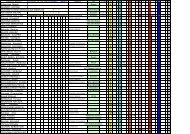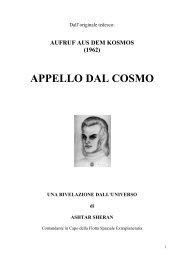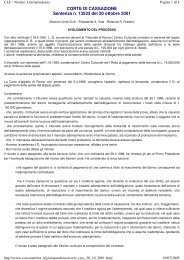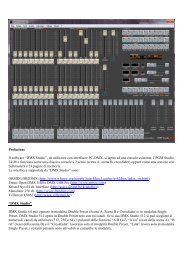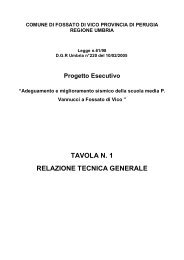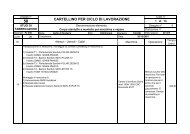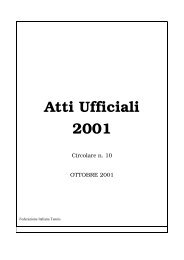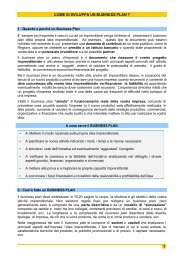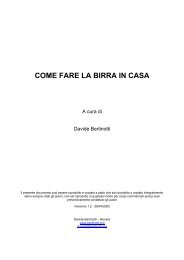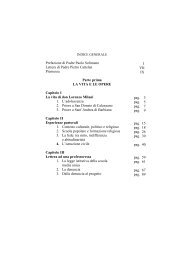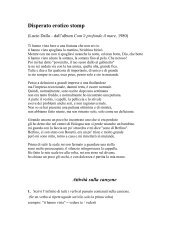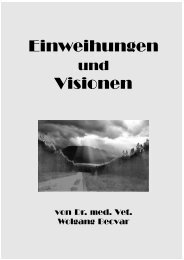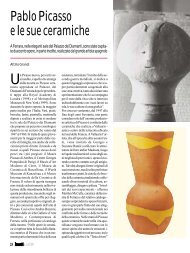Tecniche di modulazione per la trasmissione dati
Tecniche di modulazione per la trasmissione dati
Tecniche di modulazione per la trasmissione dati
You also want an ePaper? Increase the reach of your titles
YUMPU automatically turns print PDFs into web optimized ePapers that Google loves.
<strong>Tecniche</strong> <strong>di</strong> <strong>modu<strong>la</strong>zione</strong><br />
<strong>per</strong> <strong>la</strong> <strong>trasmissione</strong> <strong>dati</strong><br />
Modu<strong>la</strong>zioni ASK – FSK – PSK –<br />
QAM - TCM<br />
1
Modu<strong>la</strong>zione ASK (Amplitude ( Amplitude Shift<br />
Keying) Keying<br />
Portante fonica sinusoidale<br />
Modu<strong>la</strong>nte <strong>di</strong>gitale bipo<strong>la</strong>re (o unipo<strong>la</strong>re) unipo<strong>la</strong>re<br />
Segnale modu<strong>la</strong>to:<br />
VO () t =<br />
m(<br />
t)<br />
⋅ senω<br />
pt<br />
L’ampiezza ampiezza del<strong>la</strong> modu<strong>la</strong>nte è negativa in<br />
presenza <strong>di</strong> un bit uguale a zero<br />
(inversione <strong>di</strong> segno del<strong>la</strong> portante)<br />
Modu<strong>la</strong>zione del tipo DSB-SC DSB SC<br />
2
1,5<br />
1<br />
0,5<br />
0<br />
-0,5<br />
-1<br />
-1,5<br />
1,5<br />
0,5<br />
0<br />
-0,5<br />
-1<br />
-1,5<br />
1,5<br />
1<br />
0,5<br />
0<br />
-0,5<br />
-1<br />
-1,5<br />
1<br />
Modu<strong>la</strong>zione ASK bipo<strong>la</strong>re<br />
Segnale <strong>di</strong>gitale modu<strong>la</strong>nte<br />
0 1 2 3 4 5 6<br />
Segnale portante<br />
0 1 2 3 4 5 6<br />
Segnale modu<strong>la</strong>to<br />
0 1 2 3 4 5 6<br />
3
1,2<br />
0,8<br />
0,6<br />
0,4<br />
0,2<br />
0<br />
-0,2<br />
1,5<br />
1<br />
0,5<br />
0<br />
-0,5<br />
-1<br />
-1,5<br />
1 , 5<br />
1<br />
1<br />
0 , 5<br />
0<br />
-0 ,5<br />
-1<br />
-1 ,5<br />
Modu<strong>la</strong>zione ASK unipo<strong>la</strong>re<br />
Segnale <strong>di</strong>gitale modu<strong>la</strong>nte<br />
0 1 2 3 4 5 6<br />
Segnale portante<br />
0 1 2 3 4 5 6<br />
Segnale modu<strong>la</strong>to<br />
0 1 2 3 4 5 6<br />
4
Modu<strong>la</strong>zione FSK (Frequency<br />
( Frequency<br />
Shift Keying) Keying<br />
Assegnazione <strong>di</strong> 2 frequenze (<strong>di</strong> manipo<strong>la</strong>zione)<br />
in corrispondenza ai bit 0 e 1, appartenenti al<strong>la</strong><br />
banda del canale telefonico<br />
Non si par<strong>la</strong> <strong>di</strong> portante ma <strong>di</strong> frequenza<br />
f L + f H<br />
centrale:<br />
f 0 =<br />
2<br />
f L − f H<br />
Deviazione <strong>di</strong> frequenza:<br />
Δ f = ⇒ f L = f o − Δf<br />
; f H = f o + Δf<br />
2<br />
Segnale modu<strong>la</strong>to:<br />
() ⎟<br />
Larghezza <strong>di</strong> banda (formu<strong>la</strong> <strong>di</strong> Carson): Carson):<br />
La frequenza è <strong>la</strong> massima frequenza<br />
significativa del<strong>la</strong> modu<strong>la</strong>nte<br />
⎟<br />
t ⎛<br />
⎞<br />
V ⎜<br />
0 = AP<br />
cos<br />
⎜<br />
2πf<br />
0 + K f ∫ m t dt<br />
⎝<br />
0 ⎠<br />
B f = 2( Δf<br />
+ f max )<br />
f<br />
max<br />
5
1,2<br />
1<br />
0,8<br />
0,6<br />
0,4<br />
0,2<br />
0<br />
-0,2<br />
1,5<br />
1<br />
0,5<br />
0<br />
-0,5<br />
-1<br />
-1,5<br />
1,5<br />
1<br />
0,5<br />
-0,5<br />
-1<br />
-1,5<br />
Modu<strong>la</strong>zione FSK<br />
Segnale <strong>di</strong>gitale modu<strong>la</strong>nte<br />
0 200 400 600 800 1000 1200<br />
Segnale portante<br />
0 200 400 600 800 1000 1200<br />
Segnale modu<strong>la</strong>to<br />
0<br />
0 200 400 600 800 1000 1200<br />
6
Modu<strong>la</strong>zione PSK (Phase ( Phase Shift<br />
Keying) Keying<br />
A parità parit <strong>di</strong> frequenza aumenta <strong>la</strong> velocità velocit <strong>di</strong><br />
<strong>trasmissione</strong> rispetto al<strong>la</strong> FSK (uso <strong>di</strong> co<strong>di</strong>fica<br />
multisimbolo)<br />
multisimbolo<br />
Modu<strong>la</strong>zione <strong>di</strong> fase (2PSK, 4PSK, 8PSK)<br />
rispetto al<strong>la</strong> portante fonica<br />
Uso <strong>di</strong> co<strong>di</strong>fica multisimbolo: multisimbolo:<br />
co<strong>di</strong>ci Gray<br />
Frequenza <strong>di</strong> cifra (f ( c in bit/s, velocità velocit <strong>di</strong><br />
<strong>trasmissione</strong>) e frequenza <strong>di</strong> simbolo (f ( s in baud, baud,<br />
velocità velocit <strong>di</strong> <strong>modu<strong>la</strong>zione</strong>) fc=Nf =Nfs, , dove N è<br />
il numero <strong>di</strong> simboli raggruppati<br />
L’informazione informazione binaria è contenuta nel valore del<br />
salto <strong>di</strong> fase del<strong>la</strong> portante<br />
7
Modu<strong>la</strong>zione QAM (Quadrature<br />
Amplitude Modu<strong>la</strong>tion)<br />
Modu<strong>la</strong>tion<br />
Modu<strong>la</strong>zione mista <strong>di</strong> fase e ampiezza<br />
Permette <strong>di</strong> aumentare <strong>la</strong> velocità velocit <strong>di</strong><br />
<strong>trasmissione</strong><br />
Costruzione dei quadri-bit quadri bit (16 stati <strong>di</strong>versi)<br />
Portanti in quadratura a 1700Hz (centro<br />
del<strong>la</strong> banda telefonica) <strong>per</strong> favorire <strong>la</strong><br />
propagazione delle armoniche su<strong>per</strong>iori<br />
Modu<strong>la</strong>zione del tipo DSB-SC DSB SC<br />
8
Modu<strong>la</strong>zione TCM (Trellis ( Trellis<br />
Coded Modu<strong>la</strong>tion)<br />
Modu<strong>la</strong>tion<br />
Si basa sul<strong>la</strong> <strong>modu<strong>la</strong>zione</strong> QAM<br />
Si utilizza co<strong>di</strong>fica ridondante <strong>per</strong> evitare<br />
l’aumento aumento del<strong>la</strong> probabilità probabilit <strong>di</strong> errore dovuta<br />
all’aumentare all aumentare del numero <strong>di</strong> stati<br />
Non tutte le sequenze <strong>di</strong> simboli sono<br />
ammesse<br />
Possibilità Possibilit <strong>di</strong> correzione dell’errore dell errore (MLSE)<br />
Tecnica utilizzata nei modem V.90 V.90<br />
a 56<br />
kbit/s kbit/s<br />
9



